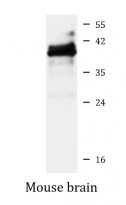ARG58172
anti-PIM2 antibody
anti-PIM2 antibody for Western blot and Human,Mouse
Overview
| Product Description | Rabbit Polyclonal antibody recognizes PIM2 |
|---|---|
| Tested Reactivity | Hu, Ms |
| Tested Application | WB |
| Host | Rabbit |
| Clonality | Polyclonal |
| Isotype | IgG |
| Target Name | PIM2 |
| Antigen Species | Human |
| Immunogen | Synthetic peptide corresponding to aa. 200 to the C-terminus of Human PIM2 (NP_006866.2). |
| Conjugation | Un-conjugated |
| Alternate Names | EC 2.7.11.1; Pim-2h; Serine/threonine-protein kinase pim-2 |
Application Instructions
| Application Suggestion |
|
||||
|---|---|---|---|---|---|
| Application Note | * The dilutions indicate recommended starting dilutions and the optimal dilutions or concentrations should be determined by the scientist. | ||||
| Positive Control | Mouse brain | ||||
| Observed Size | 38 kDa |
Properties
| Form | Liquid |
|---|---|
| Purification | Affinity purified. |
| Buffer | PBS (pH 7.3), 0.02% Sodium azide and 50% Glycerol. |
| Preservative | 0.02% Sodium azide |
| Stabilizer | 50% Glycerol |
| Storage Instruction | For continuous use, store undiluted antibody at 2-8°C for up to a week. For long-term storage, aliquot and store at -20°C. Storage in frost free freezers is not recommended. Avoid repeated freeze/thaw cycles. Suggest spin the vial prior to opening. The antibody solution should be gently mixed before use. |
| Note | For laboratory research only, not for drug, diagnostic or other use. |
Bioinformation
| Database Links |
Swiss-port # Q62070 Mouse Serine/threonine-protein kinase pim-2 Swiss-port # Q9P1W9 Human Serine/threonine-protein kinase pim-2 |
|---|---|
| Gene Symbol | PIM2 |
| Gene Full Name | Pim-2 proto-oncogene, serine/threonine kinase |
| Background | This gene encodes a protooncogene that acts as a serine/threonine protein kinase. Studies determined the encoded protein functions to prevent apoptosis and to promote cell survival.[provided by RefSeq, Nov 2009] |
| Function | Proto-oncogene with serine/threonine kinase activity involved in cell survival and cell proliferation. Exerts its oncogenic activity through: the regulation of MYC transcriptional activity, the regulation of cell cycle progression, the regulation of cap-dependent protein translation and through survival signaling by phosphorylation of a pro-apoptotic protein, BAD. Phosphorylation of MYC leads to an increase of MYC protein stability and thereby an increase transcriptional activity. The stabilization of MYC exerted by PIM2 might explain partly the strong synergism between these 2 oncogenes in tumorigenesis. Regulates cap-dependent protein translation in a mammalian target of rapamycin complex 1 (mTORC1)-independent manner and in parallel to the PI3K-Akt pathway. Mediates survival signaling through phosphorylation of BAD, which induces release of the anti-apoptotic protein Bcl-X(L)/BCL2L1. Promotes cell survival in response to a variety of proliferative signals via positive regulation of the I-kappa-B kinase/NF-kappa-B cascade; this process requires phosphorylation of MAP3K8/COT. Isoform 1 is less active in this respect. Promotes growth factor-independent proliferation by phosphorylation of cell cycle factors such as CDKN1A and CDKN1B. Involved in the positive regulation of chondrocyte survival and autophagy in the epiphyseal growth plate. [UniProt] |
| Calculated MW | 34 kDa |
| PTM | Autophosphorylated. [UniProt] |
Images (1) Click the Picture to Zoom In






